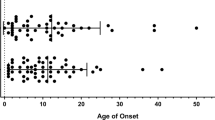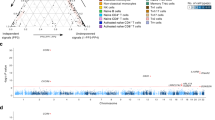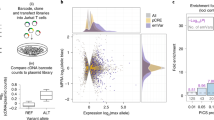Abstract
Selective immunoglobulin A deficiency (IgAD) is the most common primary immunodeficiency in Europeans. Our genome-wide association study (GWAS) meta-analysis of 1,635 patients with IgAD and 4,852 controls identified four new significant (P < 5 × 10−8) loci and association with a rare IFIH1 variant (p.Ile923Val). Peak new variants (PVT1, P = 4.3 × 10−11; ATG13–AMBRA1, P = 6.7 × 10−10; AHI1, P = 8.4 × 10−10; CLEC16A, P = 1.4 × 10−9) overlapped with autoimmune markers (3/4) and correlated with 21 putative regulatory variants, including expression quantitative trait loci (eQTLs) for AHI1 and DEXI and DNase hypersensitivity sites in FOXP3+ regulatory T cells. Pathway analysis of the meta-analysis results showed striking association with the KEGG pathway for IgA production (pathway P < 0.0001), with 22 of the 30 annotated pathway genes containing at least one variant with P ≤ 0.05 in the IgAD meta-analysis. These data suggest that a complex network of genetic effects, including genes known to influence the biology of IgA production, contributes to IgAD.
This is a preview of subscription content, access via your institution
Access options
Subscribe to this journal
Receive 12 print issues and online access
$209.00 per year
only $17.42 per issue
Buy this article
- Purchase on Springer Link
- Instant access to full article PDF
Prices may be subject to local taxes which are calculated during checkout


Similar content being viewed by others
References
Pan-Hammarström, Q. & Hammarström, L. Antibody deficiency diseases. Eur. J. Immunol. 38, 327–333 (2008).
Suzuki, K. et al. Aberrant expansion of segmented filamentous bacteria in IgA-deficient gut. Proc. Natl. Acad. Sci. USA 101, 1981–1986 (2004).
Cong, Y., Feng, T., Fujihashi, K., Schoeb, T.R. & Elson, C.O. A dominant, coordinated T regulatory cell–IgA response to the intestinal microbiota. Proc. Natl. Acad. Sci. USA 106, 19256–19261 (2009).
Borte, S. et al. Interleukin-21 restores immunoglobulin production ex vivo in patients with common variable immunodeficiency and selective IgA deficiency. Blood 114, 4089–4098 (2009).
Cao, A.T. et al. Interleukin (IL)-21 promotes intestinal IgA response to microbiota. Mucosal Immunol. 8, 1072–1082 (2015).
Ferreira, R.C. et al. High-density SNP mapping of the HLA region identifies multiple independent susceptibility loci associated with selective IgA deficiency. PLoS Genet. 8, e1002476 (2012).
Oen, K., Petty, R.E. & Schroeder, M.L. Immunoglobulin A deficiency: genetic studies. Tissue Antigens 19, 174–182 (1982).
Ludvigsson, J.F., Neovius, M. & Hammarström, L. Association between IgA deficiency & other autoimmune conditions: a population-based matched cohort study. J. Clin. Immunol. 34, 444–451 (2014).
Ferreira, R.C. et al. Association of IFIH1 and other autoimmunity risk alleles with selective IgA deficiency. Nat. Genet. 42, 777–780 (2010).
Kiryluk, K. et al. Discovery of new risk loci for IgA nephropathy implicates genes involved in immunity against intestinal pathogens. Nat. Genet. 46, 1187–1196 (2014).
Nejentsev, S., Walker, N., Riches, D., Egholm, M. & Todd, J.A. Rare variants of IFIH1, a gene implicated in antiviral responses, protect against type 1 diabetes. Science 324, 387–389 (2009).
Cunninghame Graham, D.S. et al. Association of NCF2, IKZF1, IRF8, IFIH1, and TYK2 with systemic lupus erythematosus. PLoS Genet. 7, e1002341 (2011).
Li, Y. et al. Carriers of rare missense variants in IFIH1 are protected from psoriasis. J. Invest. Dermatol. 130, 2768–2772 (2010).
Gregersen, P.K. et al. Risk for myasthenia gravis maps to a (151) Pro→Ala change in TNIP1 and to human leukocyte antigen–B*08. Ann. Neurol. 72, 927–935 (2012).
Shigemoto, T. et al. Identification of loss of function mutations in human genes encoding RIG-I and MDA5: implications for resistance to type I diabetes. J. Biol. Chem. 284, 13348–13354 (2009).
Van Eyck, L. et al. Brief report: IFIH1 mutation causes systemic lupus erythematosus with selective IgA deficiency. Arthritis Rheumatol. 67, 1592–1597 (2015).
Okada, Y. et al. Genetics of rheumatoid arthritis contributes to biology and drug discovery. Nature 506, 376–381 (2014).
Boyle, A.P. et al. Annotation of functional variation in personal genomes using RegulomeDB. Genome Res. 22, 1790–1797 (2012).
ENCODE Project Consortium. An integrated encyclopedia of DNA elements in the human genome. Nature 489, 57–74 (2012).
Tseng, Y.Y. et al. PVT1 dependence in cancer with MYC copy-number increase. Nature 512, 82–86 (2014).
Ringrose, A. et al. Evidence for an oncogenic role of AHI-1 in Sezary syndrome, a leukemic variant of human cutaneous T-cell lymphomas. Leukemia 20, 1593–1601 (2006).
Zhou, L.L. et al. AHI-1 interacts with BCR-ABL and modulates BCR-ABL transforming activity and imatinib response of CML stem/progenitor cells. J. Exp. Med. 205, 2657–2671 (2008).
Nazio, F. et al. mTOR inhibits autophagy by controlling ULK1 ubiquitylation, self-association and function through AMBRA1 and TRAF6. Nat. Cell Biol. 15, 406–416 (2013).
Pierdominici, M. et al. Role of autophagy in immunity and autoimmunity, with a special focus on systemic lupus erythematosus. FASEB J. 26, 1400–1412 (2012).
Clarke, A.J. et al. Autophagy is activated in systemic lupus erythematosus and required for plasmablast development. Ann. Rheum. Dis. 74, 912–920 (2015).
Pengo, N. et al. Plasma cells require autophagy for sustainable immunoglobulin production. Nat. Immunol. 14, 298–305 (2013).
Davison, L.J. et al. Long-range DNA looping and gene expression analyses identify DEXI as an autoimmune disease candidate gene. Hum. Mol. Genet. 21, 322–333 (2012).
Todd, J.A. et al. Robust associations of four new chromosome regions from genome-wide analyses of type 1 diabetes. Nat. Genet. 39, 857–864 (2007).
Kawamoto, S. et al. Foxp3+ T cells regulate immunoglobulin a selection and facilitate diversification of bacterial species responsible for immune homeostasis. Immunity 41, 152–165 (2014).
Chung, D., Yang, C., Li, C., Gelernter, J. & Zhao, H. GPA: a statistical approach to prioritizing GWAS results by integrating pleiotropy and annotation. PLoS Genet. 10, e1004787 (2014).
Li, J. et al. Association of CLEC16A with human common variable immunodeficiency disorder and role in murine B cells. Nat. Commun. 6, 6804 (2015).
Schuster, C. et al. The autoimmunity-associated gene CLEC16A modulates thymic epithelial cell autophagy and alters T cell selection. Immunity 42, 942–952 (2015).
Yaspan, B.L. et al. Genetic analysis of biological pathway data through genomic randomization. Hum. Genet. 129, 563–571 (2011).
Lee, P.H., O'Dushlaine, C., Thomas, B. & Purcell, S.M. INRICH: interval-based enrichment analysis for genome-wide association studies. Bioinformatics 28, 1797–1799 (2012).
Onengut-Gumuscu, S. et al. Fine mapping of type 1 diabetes susceptibility loci and evidence for colocalization of causal variants with lymphoid gene enhancers. Nat. Genet. 47, 381–386 (2015).
Schmidl, C. et al. The enhancer and promoter landscape of human regulatory and conventional T-cell subpopulations. Blood 123, e68–e78 (2014).
Fontenot, J.D. et al. Regulatory T cell lineage specification by the forkhead transcription factor Foxp3. Immunity 22, 329–341 (2005).
Bennett, C.L. et al. The immune dysregulation, polyendocrinopathy, enteropathy, X-linked syndrome (IPEX) is caused by mutations of FOXP3. Nat. Genet. 27, 20–21 (2001).
Notarangelo, L.D. et al. Primary immunodeficiencies: 2009 update. J. Allergy Clin. Immunol. 124, 1161–1178 (2009).
Magnusson, P.K. et al. The Swedish Twin Registry: establishment of a biobank and other recent developments. Twin Res. Hum. Genet. 16, 317–329 (2013).
Salvi, E. et al. Genomewide association study using a high-density single nucleotide polymorphism array and case–control design identifies a novel essential hypertension susceptibility locus in the promoter region of endothelial NO synthase. Hypertension 59, 248–255 (2012).
Mitchell, M.K., Gregersen, P.K., Johnson, S., Parsons, R. & Vlahov, D. The New York Cancer Project: rationale, organization, design, and baseline characteristics. J. Urban Health 81, 301–310 (2004).
Price, A.L. et al. Principal components analysis corrects for stratification in genome-wide association studies. Nat. Genet. 38, 904–909 (2006).
Price, A.L. et al. Long-range LD can confound genome scans in admixed populations. Am. J. Hum. Genet. 83, 132–135, author reply 135–139 (2008).
Kosoy, R. et al. Ancestry informative marker sets for determining continental origin and admixture proportions in common populations in America. Hum. Mutat. 30, 69–78 (2009).
Tian, C. et al. Analysis and application of European genetic substructure using 300 K SNP information. PLoS Genet. 4, e4 (2008).
Purcell, S. et al. PLINK: a tool set for whole-genome association and population-based linkage analyses. Am. J. Hum. Genet. 81, 559–575 (2007).
Delaneau, O., Zagury, J.F. & Marchini, J. Improved whole-chromosome phasing for disease and population genetic studies. Nat. Methods 10, 5–6 (2013).
Howie, B., Fuchsberger, C., Stephens, M., Marchini, J. & Abecasis, G.R. Fast and accurate genotype imputation in genome-wide association studies through pre-phasing. Nat. Genet. 44, 955–959 (2012).
Marchini, J. & Howie, B. Genotype imputation for genome-wide association studies. Nat. Rev. Genet. 11, 499–511 (2010).
Pruim, R.J. et al. LocusZoom: regional visualization of genome-wide association scan results. Bioinformatics 26, 2336–2337 (2010).
Benjamini, Y. & Hochberg, Y. Controlling the false discovery rate: a practical and powerful approach to multiple testing. J. R. Stat. Soc. B 57, 289–300 (1995).
Ogata, H. et al. KEGG: Kyoto Encyclopedia of Genes and Genomes. Nucleic Acids Res. 27, 29–34 (1999).
Dixon, A.L. et al. A genome-wide association study of global gene expression. Nat. Genet. 39, 1202–1207 (2007).
Duan, S. et al. Genetic architecture of transcript-level variation in humans. Am. J. Hum. Genet. 82, 1101–1113 (2008).
He, X. et al. Sherlock: detecting gene–disease associations by matching patterns of expression QTL and GWAS. Am. J. Hum. Genet. 92, 667–680 (2013).
Yang, J., Lee, S.H., Goddard, M.E. & Visscher, P.M. GCTA: a tool for genome-wide complex trait analysis. Am. J. Hum. Genet. 88, 76–82 (2011).
Barrett, J.C. et al. Genome-wide association study and meta-analysis find that over 40 loci affect risk of type 1 diabetes. Nat. Genet. 41, 703–707 (2009).
Acknowledgements
We thank the individuals who participated in this study as case and control study subjects. We thank B. Yaspan, J. Kim, J. Sitrin and T. Hung for insightful discussion, J. Tom and O. Mayba for helpful feedback on a manuscript draft, and A. Bruce for sharing her graphical expertise. Genentech funded the current GWAS. A. Lee and P. Gregersen performed sample genotyping at the Laboratory of Genomics and Human Genetics at the Feinstein Institute for Medical Research. These studies were supported by the US National Institutes of Health (U19AI067152 and AR043274), the Swedish Research Council, the European Research Council (242551-ImmunoSwitch), EURO-PADnet grant 201549, CETOCOEN PLUS and the Fondazione C. Golgi, Brescia, Italy. Financial support was also provided through the regional agreement on medical training and clinical research (ALF) between the Stockholm County Council and Karolinska Institutet. Population allele and genotype frequencies were obtained from a data source funded by the Nordic Center of Excellence in Disease Genetics based on regional samples from Finland and Sweden. The Helsinki 4 study was supported by the Yale Center for Human Genetics and Genomics and the Yale Program on Neurogenetics and by US National Institutes of Health grants R01NS057756 and U24NS051869.
Author information
Authors and Affiliations
Contributions
P.G.B. and D.C. carried out the analyses for this study. P.G.B., L.H., T.W.B., R.R.G. and T.B. conceived and directed this study. L.H., Q.P.-H., A.P., V.L., T.F., J.L., E.U., L.F.P., V.F. and V.T. performed subject diagnosis, coordinated the enrollment of subjects and provided access to genotyping data sets. M.F.S. and J.M. provided access to genotypes for healthy controls. M.F.S. provided guidance for addressing population structure due to ancestry. M.F.S., Q.P.-H., R.C.F., T.B., R.R.G. and W.O. contributed to data access and analysis. P.G.B., T.W.B., L.H. and R.R.G. wrote the manuscript with collaboration from coauthors. All authors discussed the results and commented on the manuscript.
Corresponding authors
Ethics declarations
Competing interests
The authors declare no competing financial interests.
Integrated supplementary information
Supplementary Figure 1 Association plot for the significant (P < 5 × 10−8) IgAD GWAS locus at HLA-DQ.
rs116041786 hg19 has been renamed as rs9272226 in newer builds. The regional association plot displays P values from a genome-wide meta-analysis of ~9.5 million variants in 1,635 patients with IgAD and 4,852 controls. Each dot represents a P value for a genotyped or imputed SNP, where the highest dot has the smallest P value and is labeled with the SNP name; the color of the other dots represents the level of linkage disequilibrium (r2) with the peak SNP. The lines at the top of the plot represent the location and number of directly genotyped SNPs in each cohort.
Supplementary Figure 2 Association plot for the significant (P < 5 × 10−8) IgAD GWAS locus at IFIH1.
The regional association plot displays P values from a genome-wide meta-analysis of ~9.5 million variants in 1,635 patients with IgAD and 4,852 controls. Each dot represents a P value for a genotyped or imputed SNP, where the highest dot has the smallest P value and is labeled with the SNP name; the color of the other dots represents the level of linkage disequilibrium (r2) with the peak SNP. The lines at the top of the plot represent the location and number of directly genotyped SNPs in each cohort.
Supplementary Figure 3 Association plot for the significant (P < 5 × 10−8) IgAD GWAS locus at PVT1.
The regional association plot displays P values from a genome-wide meta-analysis of ~9.5 million variants in 1,635 patients with IgAD and 4,852 controls. Each dot represents a P value for a genotyped or imputed SNP, where the highest dot has the smallest P value and is labeled with the SNP name; the color of the other dots represents the level of linkage disequilibrium (r2) with the peak SNP. The lines at the top of the plot represent the location and number of directly genotyped SNPs in each cohort.
Supplementary Figure 4 Association plot for the significant (P < 5 × 10−8) IgAD GWAS locus at ATG13–AMBRA1.
The regional association plot displays P values from a genome-wide meta-analysis of ~9.5 million variants in 1,635 patients with IgAD and 4,852 controls. Each dot represents a P value for a genotyped or imputed SNP, where the highest dot has the smallest P value and is labeled with the SNP name; the color of the other dots represents the level of linkage disequilibrium (r2) with the peak SNP. The lines at the top of the plot represent the location and number of directly genotyped SNPs in each cohort.
Supplementary Figure 5 Association plots for the significant (P < 5 × 10−8) IgAD GWAS locus at AHI1.
The regional association plot displays P values from a genome-wide meta-analysis of ~9.5 million variants in 1,635 patients with IgAD and 4,852 controls. Each dot represents a P value for a genotyped or imputed SNP, where the highest dot has the smallest P value and is labeled with the SNP name; the color of the other dots represents the level of linkage disequilibrium (r2) with the peak SNP. The lines at the top of the plot represent the location and number of directly genotyped SNPs in each cohort.
Supplementary Figure 6 Association plot for the significant (P < 5 × 10−8) IgAD GWAS locus at CLEC16A.
The regional association plot displays P values from a genome-wide meta-analysis of ~9.5 million variants in 1,635 patients with IgAD and 4,852 controls. Each dot represents a P value for a genotyped or imputed SNP, where the highest dot has the smallest P value and is labeled with the SNP name; the color of the other dots represents the level of linkage disequilibrium (r2) with the peak SNP. The lines at the top of the plot represent the location and number of directly genotyped SNPs in each cohort.
Supplementary Figure 7 Association plot for additional IgAD GWAS loci with P < 1 × 10−5.
The Manhattan association plot displays P values from a genome-wide meta-analysis of ~9.5 million variants in 1,635 patients with IgAD and 4,852 controls. Each dot represents a P value for a genotyped or imputed SNP, where the highest dot has the smallest P value. Loci with P values that did not reach genome-wide significance but had P < 1 × 10−5 are labeled.
Supplementary Figure 8 GTEx box plot of AHI1 gene expression for the cis-eQTL rs2179781 in esophagus mucosa (n = 241).
The box plot displays gene expression levels for the novel IgAD locus AHI1 stratified by genotype at the rs2179781 cis-eQTL in esophagus mucosa, based on GTEx analysis release v6 (http://gtexportal.org/). The reference allele is A and was associated with reduced risk for IgAD (P = 8.8 × 10−10) and reduced AHI1 expression (P = 3 × 10−12). This eQTL had the strongest log Bayes factor (LBF) score (6.83) in the Bayesian statistical framework Sherlock. “Homo Ref” refers to the homozygous reference allele genotype, AA; “Het” refers to the heterozygous genotype, AC; and “Homo Alt” refers to the homozygous alternate allele genotype, CC.
Supplementary information
Supplementary Text and Figures
Supplementary Figures 1–8 and Supplementary Tables 1–7. (PDF 2609 kb)
Rights and permissions
About this article
Cite this article
Bronson, P., Chang, D., Bhangale, T. et al. Common variants at PVT1, ATG13–AMBRA1, AHI1 and CLEC16A are associated with selective IgA deficiency. Nat Genet 48, 1425–1429 (2016). https://doi.org/10.1038/ng.3675
Received:
Accepted:
Published:
Issue Date:
DOI: https://doi.org/10.1038/ng.3675
This article is cited by
-
Shared genetic risk factors and causal association between psoriasis and coronary artery disease
Nature Communications (2022)
-
Linear and circular PVT1 in hematological malignancies and immune response: two faces of the same coin
Molecular Cancer (2020)
-
The Epidemiology and Clinical Manifestations of Autoimmunity in Selective IgA Deficiency
Clinical Reviews in Allergy & Immunology (2020)
-
Follow-up and outcome of symptomatic partial or absolute IgA deficiency in children
European Journal of Pediatrics (2019)
-
C-type lectins in immunity and homeostasis
Nature Reviews Immunology (2018)



